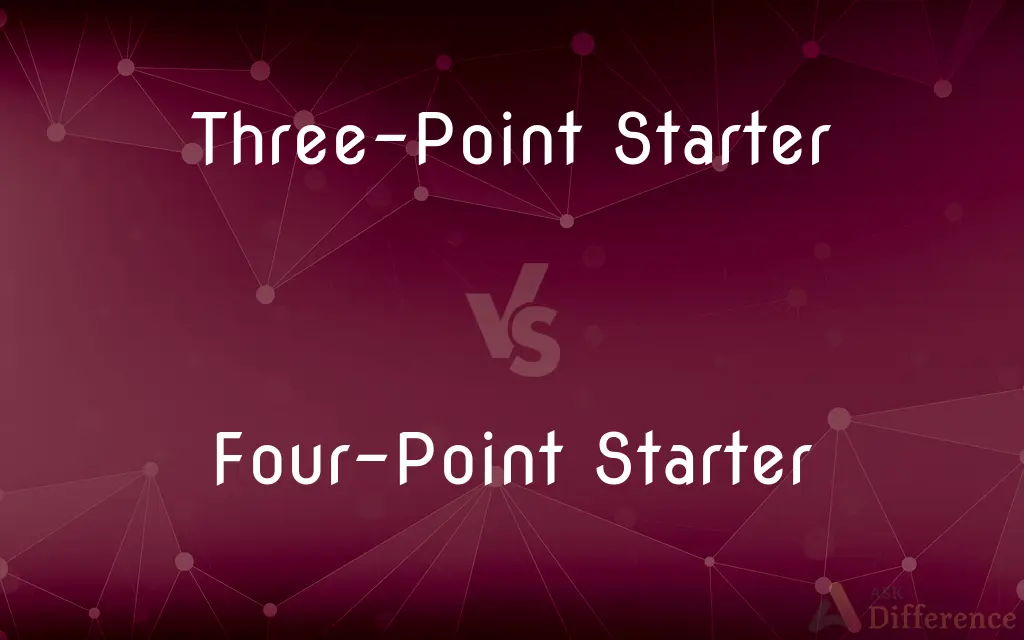Three-Point Starter vs. Four-Point Starter — What's the Difference?
By Tayyaba Rehman — Published on January 28, 2024
A Three-Point Starter uses three connections for starting DC motors, ensuring safe operation, while a Four-Point Starter includes an additional connection for better voltage regulation.

Difference Between Three-Point Starter and Four-Point Starter
Table of Contents
ADVERTISEMENT
Key Differences
The Three-Point Starter, named for its three connections – armature, field, and supply – is designed to start and protect DC motors from high starting currents. Its key components include a handle, overload release, and field current control. The Four-Point Starter, with an extra connection for voltage regulation, adds another layer of protection, particularly in variable supply voltage situations.
In a Three-Point Starter, the voltage coil is connected in series with the field coil, making it sensitive to field current fluctuations. This configuration can lead to a 'field weakening' problem under certain conditions. The Four-Point Starter addresses this issue by connecting the voltage coil directly to the supply line, independent of the field current, providing stable operation even with varying field currents.
The Three-Point Starter is simpler and more cost-effective, suitable for motors where field current fluctuations are minimal and supply voltage is stable. The Four-Point Starter, though slightly more complex, is essential for larger motors or those operating in environments with fluctuating supply voltage or field current.
When it comes to handling overloads, the Three-Point Starter's overload release mechanism protects the motor by breaking the circuit if the current exceeds a safe level. The Four-Point Starter, with its independent voltage coil, offers a more reliable overload protection, as it is unaffected by variations in field current.
Overall, the choice between a Three-Point and a Four-Point Starter depends on the motor's size, application, and the stability of the supply voltage. Three-Point Starters are adequate for smaller, less demanding environments, while Four-Point Starters are better suited for larger, more variable operations.
ADVERTISEMENT
Comparison Chart
Connection Points
Three connections: armature, field, and supply
Four connections, including an independent voltage coil
Voltage Coil Connection
Connected in series with the field coil
Directly connected to the supply line
Suitability
Suitable for smaller motors with stable supply voltage
Essential for larger motors or fluctuating supply voltage
Overload Protection
Overload release mechanism sensitive to field current
More reliable protection, unaffected by field current
Complexity and Cost
Simpler and more cost-effective
Slightly more complex and higher cost
Compare with Definitions
Three-Point Starter
Has a handle, overload release, and field current control.
Adjusting the field current control on the Three-Point Starter fine-tunes the motor operation.
Four-Point Starter
Includes an extra connection for voltage regulation in DC motors.
The Four-Point Starter's additional connection stabilizes the motor under variable voltage.
Three-Point Starter
Protects motors from high starting currents.
The overload release in the Three-Point Starter prevents motor damage.
Four-Point Starter
Provides stable operation with varying field currents.
Despite field current fluctuations, the Four-Point Starter maintained motor performance.
Three-Point Starter
A device with three connections used for starting DC motors.
The Three-Point Starter effectively controlled the motor's starting current.
Four-Point Starter
Slightly more complex but offers better protection.
Although more complex, the Four-Point Starter was worth it for its advanced features.
Three-Point Starter
Sensitive to field current fluctuations.
The Three-Point Starter may struggle with field weakening in certain conditions.
Four-Point Starter
Suitable for larger motors and fluctuating voltages.
For our industrial motor, the Four-Point Starter was essential due to variable supply voltage.
Three-Point Starter
Ideal for stable voltage applications.
We used a Three-Point Starter for our small DC motor, as the supply voltage was consistent.
Four-Point Starter
Offers more reliable overload protection.
The independent voltage coil in the Four-Point Starter enhances overload safety.
Common Curiosities
How do the connections differ between the two?
Three-Point has armature, field, supply; Four-Point adds an independent voltage coil.
What is a Three-Point Starter?
A device for starting DC motors, with three connection points.
Does the Four-Point Starter enhance motor longevity?
Yes, by providing better protection and stable operation.
Is the Four-Point Starter more complex to implement?
Slightly, due to its additional connection and voltage regulation features.
Can I use a Three-Point Starter in a fluctuating power supply?
It's not recommended; the Four-Point Starter is better suited for that.
What is a Four-Point Starter?
Similar to a Three-Point Starter but with an additional connection for voltage regulation.
Which is more suitable for fluctuating voltage?
The Four-Point Starter, due to its voltage regulation capability.
Are both types of starters used for DC motors?
Yes, both are designed for starting and protecting DC motors.
Which starter is better for large industrial motors?
The Four-Point Starter, especially in variable environments.
In what applications is the Three-Point Starter typically used?
In smaller, less demanding motors with stable power supply.
Can the Three-Point Starter handle voltage fluctuations?
It's less effective than the Four-Point in fluctuating conditions.
Which starter is more cost-effective?
The Three-Point Starter is generally more cost-effective.
How does the voltage coil connection affect performance?
In Four-Point, the direct supply line connection offers more stable operation.
How does overload protection differ between the two?
Four-Point offers more reliable protection, independent of field current.
Are there any special maintenance requirements for these starters?
Regular inspection and maintenance are important for both, especially to ensure the reliability of their protective features.
Share Your Discovery

Previous Comparison
Fortuner vs. Harrier
Next Comparison
Special Education vs. Inclusive EducationAuthor Spotlight
Written by
Tayyaba RehmanTayyaba Rehman is a distinguished writer, currently serving as a primary contributor to askdifference.com. As a researcher in semantics and etymology, Tayyaba's passion for the complexity of languages and their distinctions has found a perfect home on the platform. Tayyaba delves into the intricacies of language, distinguishing between commonly confused words and phrases, thereby providing clarity for readers worldwide.















































